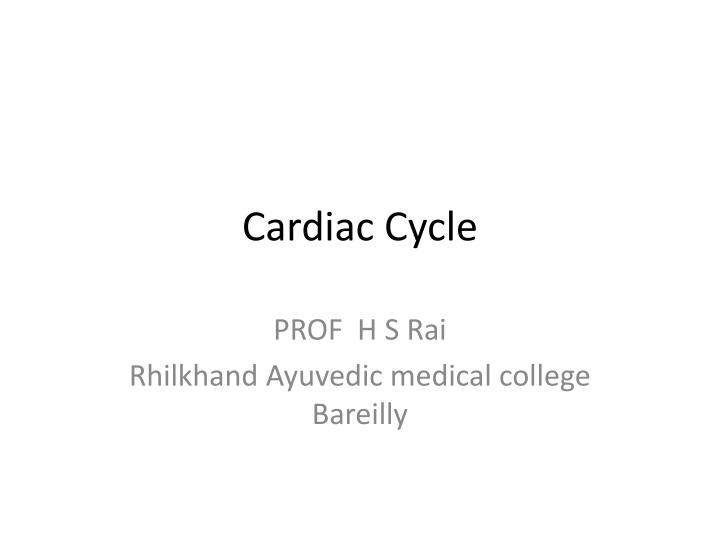
Cardiac Cycle and its Stages
Explore the intricacies of the cardiac cycle, from systole to diastole, and delve into the sequential events that occur during each heartbeat. Follow the coordinated rhythm of the heart through stages like isovolumetric contraction, rapid ventricular ejection, and slow ventricular filling. Gain insights into the dynamic process of cardiac function and learn about the role of atrial and ventricular pressure changes in maintaining healthy heart function.
Download Presentation

Please find below an Image/Link to download the presentation.
The content on the website is provided AS IS for your information and personal use only. It may not be sold, licensed, or shared on other websites without obtaining consent from the author. If you encounter any issues during the download, it is possible that the publisher has removed the file from their server.
You are allowed to download the files provided on this website for personal or commercial use, subject to the condition that they are used lawfully. All files are the property of their respective owners.
The content on the website is provided AS IS for your information and personal use only. It may not be sold, licensed, or shared on other websites without obtaining consent from the author.
E N D
Presentation Transcript
Cardiac Cycle PROF H S Rai Rhilkhand Ayuvedic medical college Bareilly
Definition of cardiac cycle ,Sequence of coordinated events taking place in heart during each beat, =systole +diastole Atrial contraction Contraction of atria -Pressure is LA is increased .production of a wave (pressure wave) pressure in atria is more than ventricle consider Happening in ventricle Happening in aorta what is happening in atria MV opening AV is already closed 80% filling is already done end diastolic volume Mild increase of pressure in V
Cardiac cycle 2ndstage Isovolumetric contraction Pressure in V increasee P in v is more tha AP CLOSURE of MV ,pruduction of S1 Pressure in V in less tha aorta VENTRICLE contract as closed chamber Amount and volume ventricle remain same Pressure in ventricle incresese continuosly Pressure in atria increases due to blood coming from lung Pruduction of c wave due ro closure of MV ,C WAVE
Rapid ventricular ejection phase Opening of AV Blood is ejected rapidaly in aorta Ventricle is still contracting and pressure in V is 120mmhg more than aorta LA working as resevoir prouction of v wave In atria Rapid flow of blood from V to Aorta
Slow ventricular ejection phase MV remain closed Pressure in Ventricle is still higher LA pressure is increasing and v wave increases Ventricle start relaxing LA still reservoir Pressure in v still falling but more than aorta Aorta sqeezing to pump the blood
Iso volumetric relaxation Ventricle is relaxing LA as reservoir Pressure in V fall rapidly Closure of AV due to pressure falling in ventricle Pressure in aorta = to ventricle MV still closed Ventricle pressure is still high to atria Ventricle relax as close chamber
Rapid ventricular passive filling MV open V wave in atria fall down Pressure in Ventricle fall down Rapid ventricular passive filling without atrial contraction
Slow passive ventricular filling or diastasis longest phase AV closed MV opened blood in V is Esv plus ventricular filling Atria is not working as revoir but as conduit or pipe Blood from lung come to ventricle
Atrale diastole is long .7 second Atril systole .1second Ventricular systole .3 second Ventricular diastole .5 second
